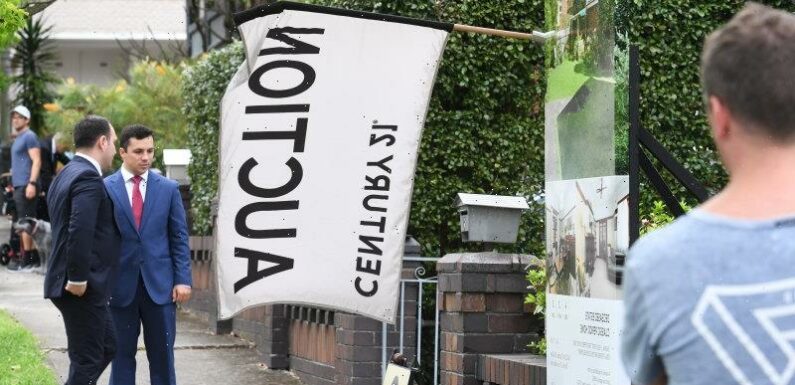
Key points
- The RBA is expected to use its first meeting of the year next week to lift the cash rate another quarter of a percentage point.
- Deutsche Bank Australia’s senior economist also expects 25 basis point increases in March, May and August.
- S&P Global says it expects the Australian economy to continue growing despite the higher rate settings already put in place by the RBA.
Home buyers could face another four interest rate rises by August as the Reserve Bank struggles to bring down inflation, putting more downward pressure on the property market and adding to cost-of-living pressures.
As one of the world’s largest credit agencies affirmed the nation’s AAA credit rating, Deutsche Bank Australia senior economist Phil O’Donaghoe said on Monday the RBA was likely to drive the official cash rate to 4.1 per cent.
Interest rates are tipped to climb another full percentage point by August as the Reserve Bank attempts to slow inflation.Credit:Peter Rae
The Reserve is in the midst of its most aggressive tightening of monetary policy since 1994, taking the cash rate to 3.1 per cent from 0.1 per cent in April last year. It is expected to use its first meeting of the year next week to lift the cash rate another quarter of a percentage point.
Central banks around the world have lifted interest rates over the past 12 months in reaction to soaring inflation. Australia’s annual inflation rate hit a 30-year high of 7.8 per cent in the December quarter.
O’Donaghoe, who previously expected the cash rate to peak at 3.35 per cent, said the most recent consumer price index report suggested the Reserve Bank had to lift interest rates much higher if it were to bring inflation under control.
“[With] the stronger than expected December-quarter CPI for Australia, and the apparent resilience in household spending over the Christmas/new year period, we no longer think a 3.35 per cent terminal rate will be enough to bring Australian inflation back to target this cycle,” he said.
“While the RBA will likely move more slowly in 2023 than it did in 2022, we now expect four more 25 basis point hikes this year: 25 basis points in each of February and March, and 25 basis points each at the May and August meetings.”
Four more quarter of a percentage point rate rises would increase the monthly repayments on a $750,000 mortgage by $480. That would be on top of the cumulative $1300 increase in repayments from last year’s rate rises over the same period.
The last time the cash rate was above 4 per cent was in early 2012 as the RBA was cutting interest rates to help support the economy. Inflation at the time was 1.6 per cent.
O’Donaghoe said much hinged on how consumers reacted to last year’s eight consecutive interest rate rises, noting if people continued to spend, the RBA might have to push up rates even higher.
Data to be released on Tuesday by the Australian Bureau of Statistics is expected to show a fall in the value of retail sales through December. Retail activity jumped by 1.4 per cent in November, partly due to highly advertised Black Friday and Cyber Monday sales. A drop in retail activity would be in addition to the fall in house and apartment prices.
CoreLogic’s daily home index shows values over the past three months down by 4 per cent in Sydney to January 30. Over the same period, values have fallen by 3.1 per cent in Melbourne.
Westpac chief economist Bill Evans said he expected the Reserve Bank to continue lifting rates to deal with ongoing inflation, although he believed it would stop short of taking the cash rate beyond 4 per cent.
“Persistent inflation pressures will see the RBA board raising the cash rate in February and March. After a pause in April, we expect a final move at the May meeting, in recognition of the persistence of demand-related inflation in the first half of 2023,” he said.
Ratings agency S&P Global on Monday said it expected the Australian economy to continue growing despite the higher rate settings put in place by the Reserve. The agency reaffirmed its AAA rating of Australia, which is one of just 11 nations with the highest possible credit rating.
S&P analyst Anthony Walker said the economic outlook for Australia was sound, although real GDP growth would slow in response to the Reserve Bank’s actions.
“Australian consumers are particularly sensitive to rising interest rates given their high level of household debt. Therefore, we expect consumption to be below trend over our forecast period as mortgage payments rise,” he said.
“Australia’s economy will likely avoid recession and expand over the next three years. This reflects low unemployment and high commodity prices. Australia benefits from being a net energy exporter.”
Finance Department figures last week showed the federal budget bottom line was $11.5 billion better than had been forecast by Treasurer Jim Chalmers in October.
Chalmers said S&P’s decision backed the government’s budget strategy.
“This is a strong endorsement of the Albanese government’s budget and economic plan. S&P has recognised Australia’s improving budget balance, spending restraint and reforms to sustain economic growth,” he said.
Walker said the budget deficit and total government debt were on track to improve over the coming years.
“Reinforcing our assessment of Australia’s fiscal position is our view that it has displayed more willingness than its peers to raise revenues and contain expenditures,” he said.
Cut through the noise of federal politics with news, views and expert analysis from Jacqueline Maley. Subscribers can sign up to our weekly Inside Politics newsletter here.
Most Viewed in Politics
From our partners
Source: Read Full Article
